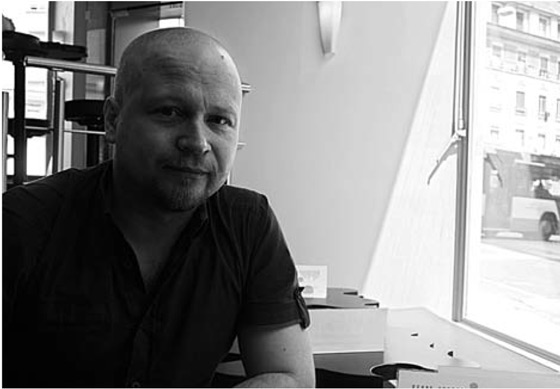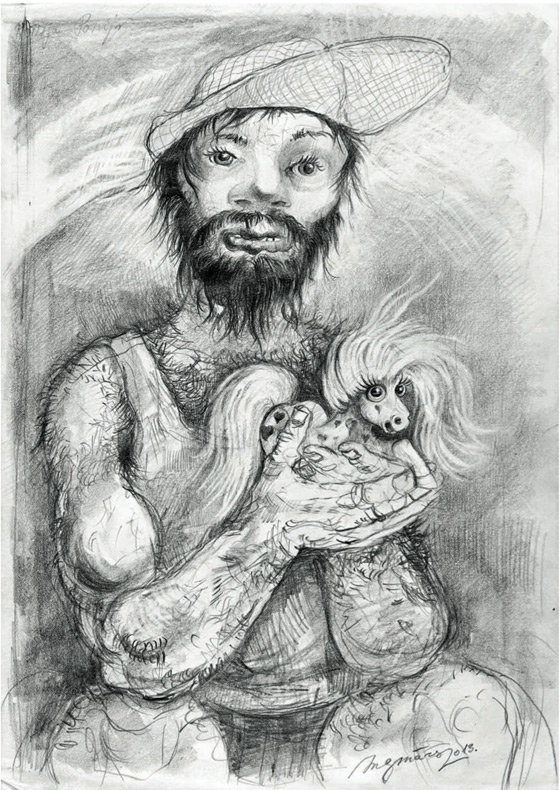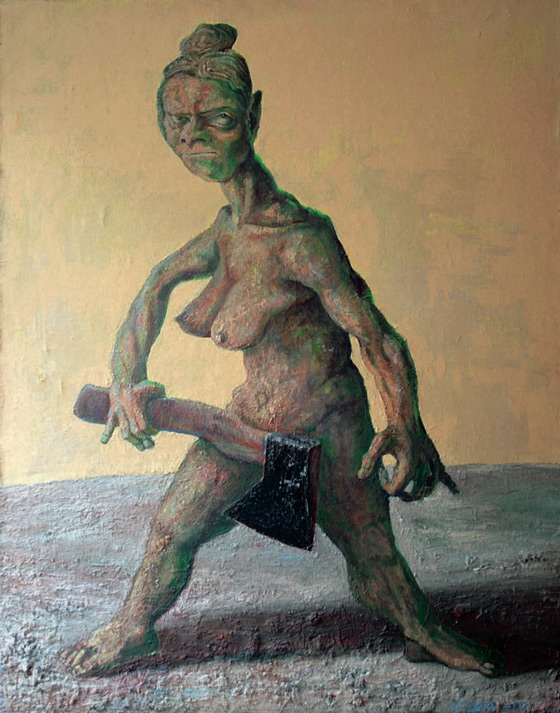|
|
| Metamorphoses of the freak in the works of Ingmārs Usas Laine Kristberga, Screen Media and Art Historian | |
| Not much has been written about Ingmārs Usas, an artist and a teacher at Janis Rozentals Art High school, and mostly in art reviews the imagery found in his works has been characterised as ‘grotesque’. The human body seems to be deformed, even crippled and freakish; its gender and sexuality often undeterminable; the children remind us of the photographs once taken in photo salons, where they anxiously look into the lens; adult men, covered in tattoos and body hair, play with sweets or hold toy ponies in their arms; punk-looking clowns and partially clothed women not corresponding to the principles of classical beauty and harmony also seem as if belonging to episodes of some horror thriller. But is the ugliness really so ugly, monstrous and unattractive that it can only be applied to the kinds of artistic experience involving fear, anxiety and violence? As Umberto Eco has indicated in his overview on the history of ugliness, the works of art that were made in the aesthetics of kitsch, trash and especially camp, “emerged as a sign of recognition to the intellectual elite, which was so confident in its refined taste that it could afford to liberate from condemnation those forms of art that previously were considered as examples of poor taste”.(1) This time I will refrain from making judgment about such an ambiguous term as ‘taste’, yet I will offer an insight in nuances rarely featuring in mainstream aesthetics, analysing the works of Usas through the concept of the freak. In his book Freaks: Myths and Images of the Secret Self (1978), American literary critic Leslie Fiedler has provided the definition of ‘freak’, pointing to the fact that “the freak challenges the conventional boundaries between male and female, sexed and sexless, animal and human, large and small, self and other, and consequently between reality and illusion, experience and fantasy, fact and myth”.(2) More recently, critics such as Margrit Shildrick, Rosemarie Garland Thomson and Rachel Adams have developed Fiedler’s argument, pointing out that the concept of the freak is a fluid one and continually evolves in relation to cultural norms.(3) This definition also echoes with the performativity theory elaborated by the gender theoretician Judith Butler, who argues that gender is also fluid, that is, there is no strictly binary and biologically determined division of gender into the masculine and feminine, but instead, gender is performance – the manner in which people behave in various situations.(4) In similar fashion, there is no fixed meaning to the body of the freak, because there actually is no essential body which exists prior to the discourse that creates it.(5) | |
 Ingmārs Usas. 2013 Photo from the private archive of Ingmārs Usas | |
| The discourse or the institution that might be considered responsible for creating the freak is the freak show. As Fiedler writes, historically freaks have always been the object of display, subjected to the public gaze, and were often exhibited in European market squares and county fairs right up to the late 18th century, when people referred to as ‘monsters’ or people with congenital, biological defects were transferred to such newly-established institutions as anatomy clinics, where they could be analysed in the context of the recently-established practice of experimental biomedicine. Thus, the science of teratology was born, aimed at studying malformations of human and animal embryos, in order to understand the genesis of monstrous beings in the light of evolutionary theory.(6) According to its etymological origins, teras in Greek means both ‘monster’ and ‘marvel’, indicating the ambivalence implied in the term itself: it is horrible and wonderful, the object of abhorrence and adoration at the same time. Philosopher Rosi Braidotti has examined the discourse of the monstrous in a detailed manner, also in the context of feminist theo- ries, and is of the opinion that this discourse brings up the question of the different and the other.(7) Following the analysis of the philosophical ratio suggested by Derrida and other contemporary French philosophers, it can be argued that Western thought has a logic of binary oppositions that treats difference as the opposite of the accepted norm.(8) In this dualistic system, the monstrous is perceived as the negative pole, and it inevitably results in the fact that otherness may be depicted only as something abnormal, pathological and nega- tive. Thus a question arises – “can we liberate difference from these normative connotations and can we learn to think differently about difference”?(9) Braidotti hypothetically distinguishes three periods of the discourse of the monstrous: the Greek and Roman period (Classical mythology), the 16th – 17th century (dwarves and court fools), and the mid-19th century – nowadays (development of the scientific discourse). When comparing these three periods, Braidotti concludes that nowadays the wonderful and fantastic dimension of the mon- strous is lost, due to the development of new technologies and medi- cal science.(10) The medicalization and perfectability of the body, as well as the abolition of anomalies mark the loss of fascination about the living organism, its mysteries and functions. Braidotti asks where the passion of wonder has gone, and what happened to the fascina- tion of difference, when [the monstrous bodies] became locked up in the laboratories of the modern alchemists.(11) Fiedler, on the other hand, sees a connection between the 20th century medicalization of monsters, the scientific appropriation of their generative secrets and an increased commodification of the monster as freak, that is, an object of display. In contemporary culture, departures from the norm are described as being freaky, and since the 1960s an entire youth subculture has developed around freaks, with special emphasis on genetic mutation as a sign of non-conformism and social rebellion. In popular culture genres such as science fiction, horror novels and films, underground comics and Cyberpunk, the central role is played by mutants. In comparison to the grotesque of earlier times, today the freaks are science fiction androids, cyborgs, bionic women and men. According to Braidotti, the whole rock’n’roll scene is a huge theatre of the grotesque, com- bining freaks, androgynes, as well as the aesthetics of ugliness, insanity and violence.(12) In this context it could be argued that the works of Ingmārs Usas – similarly to the historically monstrous – have the quality of fascination and repulsion at the same time, and the lack of understanding of the average viewer about the application of the ugli- ness and horror aesthetic nowadays (as opposed to, for instance, the early 20th century) even seems comprehensible. However, Usas himself emphasizes that his intention has never been to shock the viewer or to give rise to a vision of him as a provocative artist. Even if the humans or human-like creatures in his works look grotesque or even disfigured according to generally accepted norms, it does not mean that the artist has tried to depict the ugly on the basis of ugly prototypes. At the beginning of the 20th century, too, when looking at a woman’s face painted by Picasso, the average lowbrow viewer considered it an ugly portrayal of reality as opposed to the portrait of an ugly woman. Consequently a modern viewer should be educated at least so much as to be able to distinguish among the manifestation of ugliness as such (phenomena and objects causing the feelings of disgust, for example, open wounds, faeces, rotting carrion), the manifestation of formal ugliness (lack of harmony in the organic relations between the entirety and its parts), and artistic ugliness (artistic depiction of both previously mentioned forms of ugliness).(13) | |
 Ingmārs Usas. The Pony of Rony. Pencil on paper. 30x21 cm. 2013 Publicity photo Courtesy of the artist | |
| If to the imagery in Usas’s works the concept of ‘freak’ is applied – which conceptually is a much milder description than ‘monster’ – it can be concluded that they balance on the border of kitsch and camp, yet they never become ridiculously caricatured. Camp is a term that emerged at the beginning of the 20th century; however, in the 1960s it was contextualised as a means of perception and aesthetics, initially postulating it as anti-academic taste embracing popular culture and the low arts.(14) Susan Sontag in her essay Notes on Camp (1964) offers the key elements of camp, including artifice, frivolity, naïve middle-class pretentiousness and “shocking” excess. Camp aesthetics is evident in trash movies such as Pink Flamingos (1972, dir. John Waters) and Hairspray (1988, dir. John Waters). Celebrities that are usually associated with camp include the drag performer Divine, actress Marlene Dietrich, singer-songwriter Lady Gaga and others. Because camp develops in parallel with popular culture, it is in constant flux and is never strictly defined. It must be added that in the context of art analysis, camp is never applied as a categorical imperative, rather it is used as a complementary tool and, as Sontag has indicated, it offers “for art (and life) a different – a supplementary – set of standards”.(15) According to Sontag, the camp object definitely has something exaggerated and marginal, as well as a certain degree of vulgarity – even when trying to achieve subtlety. Camp is a love of the extravagant, of things-being-what-they-are-not, and the best example is Art Nouveau which converts objects into something else, like the lighting fixtures in the form of flowering plants.(16) “Camp is the triumph of the epicene style (the convertibility of “man” and “woman”, “person” and “thing””).”(17) Some of the characters in Usas’s works can definitely be seen in this aspect: the hermaphrodites and transvestites in his works Rosa from series Join the Club (2007), Sweet Life 1 (2007) and Sweet Life 2 (2007), as well as the human – amphibian in the science fiction series Ihtiandrs (2010–2012). The character in The Jellyfish Trainer (2005) looks like a hermaphrodite, too, at least in terms of the outer appearance, though Usas points out that it had not been his intention in this case. The aspect of gender performance, already mentioned, which has been analysed by Butler using the drag show as an example, features also in the drag properties and ambivalent gender identification in Usas’s work The Little Liar (2013). More grotesque than silk stockings, probably, may seem the sharp pikes that adorn the bodies of several characters, for example, in the works Sebastian, (19) Thinker from series Join the Club (2007), Let’s Speak About God (2011) and Scars 08 (2003). As pointed out by Usas, the subject of scars has been referred to both literally and metaphorically in these works. According to the artist, scars attract and repel at the same time. They can be regarded as sacred suffering, which is especially characteristic in paintings of the sacral doctrine of the Church, and they may seem ugly and repugnant. At the same time, scars can be turned into fetish objects and fashion trends. This theme resonates with the previously examined concept of the freak and the discourse of the monstrous. As the opposite pole to normality and normativity, the freak and the monster both fascinate and elicit horror. Yet at the same time they raise the issue of the other and the different, thus these concepts can also serve as political instruments: subverting, challenging and even overthrowing the established and normative order. Obviously, in a metaphorical sense, scars also serve as symbols for one’s emotional experiences and traumas suffered, but this aspect does not need further elaboration. Consequently, it is not difficult to conclude that the concept of the freak as such must be viewed beyond mainstream categories. Significant in this aspect seems to be the question posed by Braidotti: can we learn to think differently about the different? What needs to be emphasised from the point of view of the contemporary perspective, and especially Postmodern experience, however, is that the freak is a product and commodity of popular culture. Like belonging to any of the contemporary subcultures – be it goths, punks or hipsters, being a freak means to be trendy, and this trendiness can be implemented as a marketing strategy. A freak can be oversweetly banal, theatrical or grotesquely frightening. A freak can change his or her sex, and subject themselves to the knife of a plastic surgeon. A freak can announce anything to be the new fashion trend, even changing one’s ethnicity – as in the case of Michael Jackson. A freak can also be somebody who arrived into this world as a result of artificial insemination, in laboratory circumstances. This allows us to summarise that the concept of the freak can be flexibly applied to various constructions of identity, accepting different forms of existence as opposed to a strictly binary logic – the normal versus the abnormal. | |
 Ingmārs Usas. Judith. Oil on canvas. 155x122 cm. 2001 Publicity photo Courtesy of the artist | |
| When analysing Usas’s works, attention must be drawn to the historical aspect of the representation of ugliness in art, as well as the theoretical discourses on the freak and the monstrous that emerged in the 20th century and are still scrupulously examined nowadays – as evidenced by the numerous conferences and publications included in the compilations of academic articles dedicated to this subject. In the context of gender and feminist studies, too, the issues of otherness and identity are especially important, and this notion underlines the contemporaneity of this thematic direction. Likewise Usas’s works can be studied in accordance with the philosophical framework elaborated by Russian philosopher and literary critic Mikhail Bakhtin, applying his concepts of the grotesque and carnivalistic as proposed in Bakhtin’s dissertation on Francois Rabelais’ literary work (written in 1940 and published only in 1965). When analysing the artistic accomplishments of Usas, however, it seems significant that the freak is not always the different and the marginal. Just as well it could also be part of our own individuality, and even if this were not the case, it can still be very close, in the ordinary man next to us.(20) And that, to my mind, is the fascinating, and not the monstrously frightening, factor of Usas’s works. Translator into English: Laine Kristberga (1) Eko, Umberto. Neglītuma vēsture. Rīga: Jāņa Rozes apgāds, 2008, p. 408. (2) Fiedler, Leslie. Freaks: Myths and Images of the Secret Self. New York: Anchor Books, 1978, p. 24. (3) Richardson, Niall. Transgressive Bodies: Representations in Film and Popular Culture. Burlington: Ashgate Publishings, 2010, p. 8. (4) Sk.: Batlere, Džūdita. Dzimtes nemiers. Rīga: Mansards, 2012. (The key metaphor of Butler in this context is ‘drag’. By putting on the clothes of the opposite gender, drag performers subvert the ideas about gender norms and rebel against the categories that locate the gender in the identity constructing framework. The concept of the original or primary gender is being parodied in the sexual stylization practice of drag identity. Thus drag performance emphasises the difference between the anatomy and sex of the performer, which he or she performs. The concept of the gender parody does not accept that there exists only one original that would be imitated by such parodied identities.) (5) Richardson, Niall. Transgressive Bodies, p. 8. (6) Braidotti Rosi. Mothers, Monsters, and Machines. In: Conboy Katie, Medina Nadia, and Stanbury Sarah (eds). Writing on the Body. New York: Columbia University Press, 1997, pp. 71–72. (7) Ibid, p. 62 (8) See: Derrida, Jacques. L’écriture et la différence. Paris: Seuil, 1967. (9) Braidotti, Rosi. Mothers, Monsters, and Machines, p. 62 (10) Ibid, p. 71 (11) Ibid, pp. 73 – 74 (12) Ibid, p. 75 (13) See for more detail: Eko, Umberto. Neglītuma vēsture, p. 19. (14) Camp became especially popular in the 1980s, when it was analysed in the framework of the theories of Postmodernism. (15) Sontag, Susan. Notes on Camp. www.math.utah.edu/~lars/Sontag:: Notes%20on%20camp.pdf (accessed on 13.08.2013) (16) Ibid. (17) Eko, Umberto. Neglītuma vēsture, p. 412. (18) Usas’s work Saint Adrian (2007) from the series Join the Club was purchased for its collection by the Latvian National Museum of Art. (19) In 2005, Usas’s work Sebastian was selected among the final 100 from more than 8000 works to be exhibited in the show Renaissance, dedicated to remembrance of the tragic earthquake in Kobe, Japan. (20) See Ingmārs Usas’s series The Invincible Jack (2002). For these works Usas was awarded the Onassis Foundation prize in 2006. | |
| go back | |







